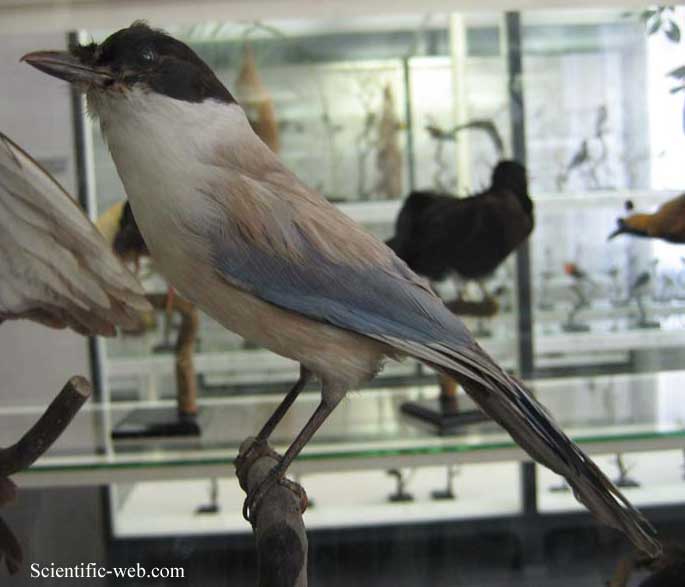Cyanopica cyanus , Photo: Michael Lahanas Cladus: Eukaryota Name Cyanopica cyanus (Pallas, 1776) Synonyms * Cyanopica cyana Reference * Reise durch verschiedene Provinzen des Russischen Reichs 3 p.694 The Azure-winged Magpie (Cyanopica cyana) is a bird in the crow family. It is 31–35 cm long and similar in overall shape to the European Magpie (Pica pica) but is more slender with proportionately smaller legs and bill. It belongs to the monotypical genus Cyanopica. It has a glossy black top to the head and a white throat. The underparts and the back are a light grey-fawn in colour with the wings and the feathers of the long (16–20 cm) tail are an azure blue. It inhabits various types of coniferous (mainly pine) and broadleaf forest, including parks and gardens in the eastern populations. It occurs in two population groups separated by a huge geographical region between. One population lives in Western Europe, specifically the southwestern part of the Iberian Peninsula, in Spain and Portugal. The other population occurs over a much larger region of eastern Asia in most of China, Korea, Japan, and north into Mongolia. Recent genetic analysis has shown that the two populations are distinct at species level,[1] under which the Iberian Azure-winged Magpie would take the name Cyanopica cooki, though this change has yet to be formally incorporated in the European bird list. Often Azure-winged Magpies find food as a family group or several groups making flocks of up to 70 birds. The largest groups congregate after the breeding season and throughout the winter months. Their diet consists mainly of acorns (oak seeds) and pine nuts, extensively supplemented by invertebrates and their larvae, soft fruits and berries, and also human-provided scraps in parks and towns. This species usually nests in loose, open colonies with a single nest in each tree. There are usually between 6–8 eggs that are incubated for 15 days. The voice is a quick fired and metallic sounding kwink-kwink-kwink usually preceded by a single krarrah. References ^ Kyukov et al, Synchronic east–west divergence in azure-winged magpies (Cyanopica cyanus) and magpies (Pica pica, Journal of Zoological Systematics and Evolutionary Research 42(4): 342-351 (2004) Source: Wikipedia, Wikispecies: All text is available under the terms of the GNU Free Documentation License |
|

